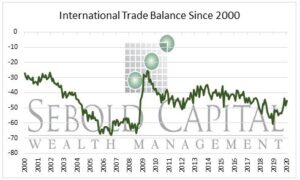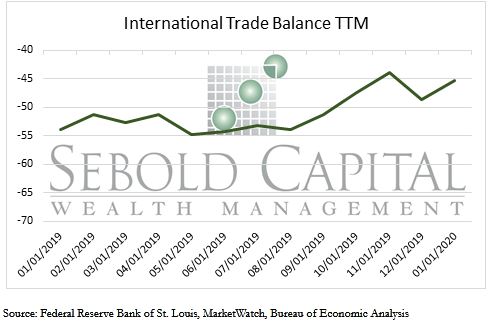 The US international trade balance is compiled by America’s Customs Agency and represents the value of all goods traded between the US and foreign nations. The balance is then calculated by subtracting total imports from total exports. A negative balance means that imports are more than exports, a positive trade balance means that exports are greater than imports.
The US international trade balance is compiled by America’s Customs Agency and represents the value of all goods traded between the US and foreign nations. The balance is then calculated by subtracting total imports from total exports. A negative balance means that imports are more than exports, a positive trade balance means that exports are greater than imports.
The international trade balance fell -6.74% in magnitude from December 2019 to January 2020 from -$48.61 billion to -$45.34 billion. The balance is 15.76% smaller than the deficit in January 2019, when it was -$53.64 billion.
The US trade balance has generally continued to fall over the past couple of years. The U.S. exports of goods decreased $1.4 billion, primarily in capital goods and industrial supplies, to $136.4 billion. However, imports also decreased by $4.1 billion in January to $203.4 billion. The deficit with China decreased $2.1 billion to $23 billion, with imports decreasing by $1.8 billion to $31.4 billion. This is most likely a result of the COVID-19 epidemic that disrupted production in China, forcing them to run below capacity, and causing declines in imports such as oil, autos, and cellphones. How much the trade deficit will continue to fall in the U.S. due to disrupted trade because of COVID-19 is uncertain but based on current trends and updates we expect the trade deficit to decline for the balance of the year.

March 16, 2020

